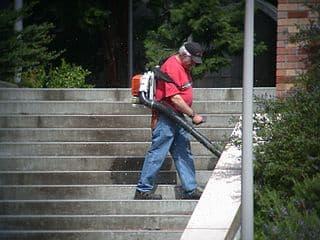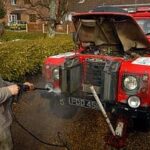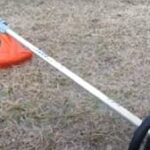As an Amazon Associate, this site earns commissions from qualifying purchases. For more information click here.
Flooding occurs when a leaf blower engine is filled with fuel but not enough air gets in. This can lead to sputtering or it may not start at all. The engine will also smell strongly of gas. Flooding often takes place after prolonged storage, but it is easy to repair.
If you have a flooded fuel injected leaf blower, shut the choke, pull the gas lever then try to start it up again. If you have a carburetor based model, take the air filter off to reach the carburetor. Lift the flap and pull the cord a few times until the engine starts.
For the rest of this post you will learn how to get a flooded leaf blower to run step by step. Both fuel injected and carburetor models are covered here.
Please keep in mind the information here is for general guidance only. Consult the operating manual that came with your leaf blower for more details.
The guide below assumes flooding is the problem. Some leaf blowers will not start due to a dirty fuel filter. If that is the case you have to clean it properly.
How to Unflood a Fuel Injected Leaf Blower
Fuel injected leaf blowers have taken great strides to minimize flooding. They are equipped with a special pump that restricts the gas that gets in. Even so, there are still times when flooding can occur. If that happens you can use the guide.
This video shows the process, but if you prefer to read, follow the directions given here.
Step 1. Close the choke
The first thing you have to do is close the choke. Your leaf blower comes with fuel management levers, and one of these is for the choke. Find the choke lever and close it.
The choke is responsible for managing air circulation. By closing it you are sealing the air inside. As pointed out earlier, engine flooding occurs when there is insufficient air available. Containing the air is only the first step however.
Note: the best way to avoid this problem is to get a high-quality leaf blower. We prefer the Husqvarna 965877502 because it is heads above other backpack blowers in terms of performance.
Step 2. Press the gas handle
Hold and press down the gas handle. Just press and hold it in that position until the engine starts.
Step 3. Start the engine
When you closed the choke you locked air in. By holding down the gas lever, the engine gets filled with fuel. Now all you have to do is pull the cord. Do this a few times and the engine should start.
If the gas and air are not yet properly mixed, the engine will sputter. Give it a few minutes to get sorted then crank it again. If you do not see a spark, you may have to reduce the air or gas in the tank.
How to Fix a Flooded Leaf Blower Carburetor
Carburetor leaf blowers get flooded due to improper gas and air mix. When there is too much gas, a leaf blower will not be able to start. If that happen you can try the following.
Step 1. Take the air filter cover off
Get a screwdriver and remove the screws that hold the air filter cover in place. Take the cover off and remove the air filter as well. You have to do this to get to the carburetor and allow the engine to take in some air.
The air filter is important, but it can also stop air from getting into the carburetor. If there is not enough air the leaf blower cannot start.
The easiest way to let air in is to take the filter off. While you are at it, clean the air filter. Look for signs of damage too. Do not use a damaged air filter because it might make things worse later on.
Step 3. Open the carburetor flap
With the air filter gone for the meantime, you should see the carburetor and the flap that is linked to the throttle. This mechanism is responsible for controlling the amount of gas the engine uses.
Get a screwdriver and lift the flap. Doing this increases the chance the engine can spark.
Step 3. Give the engine a try
Pull the cord and see if the engine starts. You should see a spark while you do this. After a few pulls the engine will start. If it does not there could be a problem with the carburetor itself. Turn the leaf blower off and check the carburetor.
Step 4. If the engine runs, put the air filter back on
After the engine starts, let it idle for a few minutes. If there is no coughing or sputtering you have fixed the problem.
After the warm up you can turn the engine off. Allow it to cool completely. The last step is to put the air filter and cover back. Since you cleaned or replaced the filter, there will be no more clogging.

Leaf Blower Maintenance Tips
A lot of things can go wrong with a leaf blower, not just a flooded engine. To prevent this from happening, regular maintenance will be necessary.
- Fuel filter – typically this is replaced every 12 months. If you are knowledgeable, you can do this yourself. Otherwise just take it to a leaf blower shop and let them take care of it. or you can use the QIUYE fuel filter replacement kit as it works with most 2-stroke trimmers.
- Fuel – follow the instructions for use. Empty the tank if you are going to store the leaf blower for several weeks. Replace the oil every four weeks. Do not allow oil to age in the machine as it could cause problems.
- Engine oil – replace every 50-60 hours or what the manufacturer recommends.
- Air filter – clean the filter after 15-20 hours of use, or whatever the manufacturer says. This will also depend on its state and performance.
- If the air filter gets dirty and makes the leaf blower hard to use, clean it more often. A rarely used leaf blower needs less frequent cleaning. Replacements are done annually or before the start of a new season.
Flooded Leaf Blower Engine FAQ
How do you prevent leaf blower engine flooding?
Empty the fuel tank if you are going to store the leaf blower for a long time. Over time, the fuel will turn gummy and block the filter. Lack of ventilation limits the amount of air that gets into the system. These and other problems all contribute to engine flooding.
Can a flooded engine fix itself?
No, it will not. The most common cause of engine flooding is lack of air. If you have a fuel injected leaf blower, you have to close the choke, press the gas lever and start the engine. If you have a carburetor unit, take the air filter off and lift the carburetor flap before starting the engine.
In both cases you have to take action. Not doing anything will not fix it. If at all that will make things worse. If you try to start the engine without any troubleshooting, it could lead to permanent damage.
What are the signs of a flooded engine?
Your leaf blower refuses to start or it initializes and then stops. The machine also reeks of gas. You might hear the engine coughing. Any or all of these are signs flooding has occurred.
Can you reset a flooded leaf blower engine?
If you suspect there is too much fuel, turn the engine on and let it run. In theory this should get rid of the excess gas until balance is achieved. In reality this does not always work.
The problem is a leaf blower usually cannot start when the engine is flooded. The best approach is to follow the instructions given here or the troubleshooting guide in your manual.
Perhaps if the flooding is minimal, you can just start the engine and let it run. Otherwise, it is best to fix the problem before running the engine.
Can you let a flooded engine idle?
For leaf blowers it is better to repair it as soon as possible. Letting it sit will not do any good. You cannot use the machine if the engine is flooded, so you have to repair the problem first.

I love the outdoors and all the tools for maintaining gardens, yards and lawns. The only thing I am more passionate about is sharing what I know about garden and outdoor equipment.


